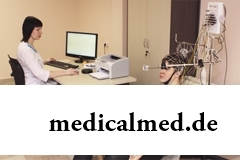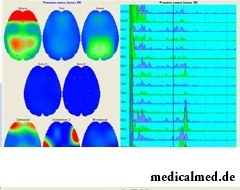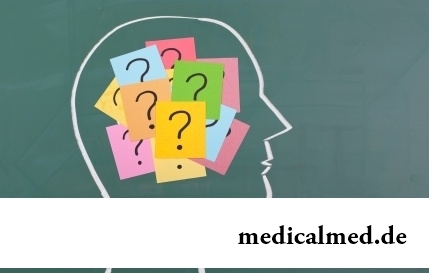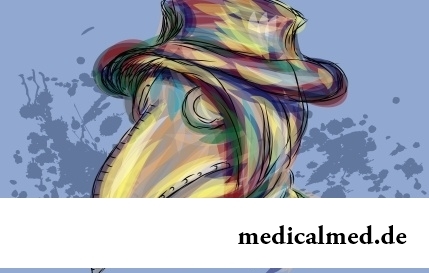





Electroencephalography
 The clinical electroencephalography is a way of a research of functional activity of a nervous system. The electroencephalography method is based on record of electric potentials of a brain and it represents summation of the simple processes proceeding in brain neurons.
The clinical electroencephalography is a way of a research of functional activity of a nervous system. The electroencephalography method is based on record of electric potentials of a brain and it represents summation of the simple processes proceeding in brain neurons.
Electroencephalography of a brain appoint at paroxysmal states, psychosomatic, cognitive, emotional, behavioural, mental, neurotic disorders, at craniocereberal injuries for assessment of their weight and assessment of dynamics of recovery of a brain, distsirkulyatorny and vascular changes, at inflammatory diseases of a nervous system, at pathologies of endocrine character.
The electroencephalography to children is appointed at perinatal disturbances of a nervous system.
Feature of a method of an electroencephalography is that it cannot be applied to diagnosing of organic damages of a nervous system, and it is not intended for statement of the final diagnosis. The advantage of an electroencephalography is that its results are objective, and it is possible to estimate a brain condition without serious intervention in the patient's organism.
The clinical electroencephalography is considered the most adequate method of assessment of a maturity of a nervous system of a condition of a brain, generally, and studying of a neurophysiological basis of mental activity.
As the electroencephalography method is implemented
To make inspection, attach electrodes which are connected to the registrar of brain activity to the head of the patient.
Electrodes and devices of registration differ depending on an objective.
 Bridge electrodes use for carrying out a clinical electroencephalography of those patients who are capable to stay some time in situation reclining or sitting and to execute commands of the neurophysiologist conducting a research. Children can use such electrodes when carrying out an encephalography after 3-5 years and the adult who are in consciousness and kontaktna.
Bridge electrodes use for carrying out a clinical electroencephalography of those patients who are capable to stay some time in situation reclining or sitting and to execute commands of the neurophysiologist conducting a research. Children can use such electrodes when carrying out an encephalography after 3-5 years and the adult who are in consciousness and kontaktna.
Chashechkovy electrodes use for a research of activity of a brain of unconscious patients, small children, for carrying out a long electroencephalography of a brain and studying of brain activity during sleep.
Needle electrodes use for inspection during operation for assessment of depth of an anesthesia and the general condition of the patient. Usually electrodes stick in head skin, and on neurosurgical operations enter them directly into brain tissue.
Electroencephalography of children
To children with deviations in speech, motive and mental development even more often recently appoint an electroencephalography. Advantage of this method is that despite the lack of attacks, the method of an electroencephalography allows to reveal the pathological hidden disturbances of brain activity.
Appoint an electroencephalography to children in such cases:
- at arrests of development, psychoemotional disturbances of the obscure origin, including in cases of purpose of the stimulating neurotropic treatment;
- for assessment of compliance of development of a brain to age of the child;
- for differential diagnosing of epilepsy and control over efficiency of treatment when there are complaints to a frequent loss of consciousness, attacks, faints, the panic attacks, tics, dying down episodes;
- at deterioration in progress of the child at school and a sharp causeless behavior disorder. The electroencephalography in these cases is used for a right choice of a method of treatment;
- at various sleep disorders: fears and nightmares, circulation and a talk in a dream;
- at tumors, injuries, disturbances of a brain blood-groove, other diseases of a brain.
There are no contraindications to carrying out an electroencephalography, the procedure does not demand special preparation.
In our intestines are born, millions of bacteria live and die. They can be seen only at strong increase, but if they gathered, then would be located in a usual coffee cup.

The immunity role in growth of the child is invaluable. The proteins-immunoglobulins produced by immune system preserve the child against diseases...
Section: Articles about health
You heard that laughter prolongs life? Researchers did not manage to establish longevity direct link with sincere fun yet, but several facts confirming beneficial influence of risibility on the state of health are clinically proved....
Section: Articles about health
Not without reason doctors say that 90% of diseases begin or develop because of misoperation of intestines. Disturbance of its functions is connected with various factors among which the important place belongs to excessive "clutter" of an intestinal path. In an organism not only the remains of food, but also mass of harmful substances which we with food accepted accumulate. Accepted to accept, and about that to remove them, did not take care. And in it a problem....
Section: Articles about health
We present to yours the TOP of the medicamentous means exerting the stimulating impact on a potentiality, i.e. on ability of a muzhcha...
Section: Articles about health
Popular joke that there are no healthy people, and is nedoobsledovanny, most of us considers an honest truth, continually it is necessary to hear that all of us are sick hardly from a school bench. It is hard to say, whether so it actually because...
Section: Articles about health
(Xerostomia) many people consider feeling of a xerostomia small and easily removable inconvenience. This delusion: the symptom can demonstrate existence of serious diseases. It is worth to remember also that saliva performs important functions in an organism: clears the surface of teeth of a food plaque, growth of pathogenic microorganisms oppresses, normalizes acid-base balance, liquefies food and helps to split the carbohydrates which are contained in it. Chronic deficit слюн...
Section: Articles about health
The nature does not stand stagnation and monotony. It is known that tissues of a human body atrophy if do not receive necessary loadings...
Section: Articles about health
The business lady, the become mother, it is necessary to solve an array of problems. But of them is main: how to combine the beloved child and work? What traps trap the working mother and how she needs to behave?...
Section: Slideshow
Practically each person is familiar with the annoying, pulling, unscrewing pains caused by overcooling of muscles of a back. In certain cases inflammatory process is not limited to discomfort, being followed by emergence of hypostasis, consolidations, temperature increase. At the wrong treatment the acute miositis can lead to a chronic disease or aggravation of other pathologies of a back (vertebral hernia, osteochondrosis) therefore it is important to pay attention to symptoms of an illness in time and to start to...
Section: Articles about health
People know that thermal sources have salutary force long ago. Treatment by natural waters is one and...
Section: Articles about health
The state of health of the person depends on many factors. One of the most important is the constant, but not exhausting a physical activity. In the presence of various illnesses specialists often advise patients to do swimming which by right borrows ведущ...
Section: Articles about health
Water with a lemon - idle time in preparation drink which supporters of a healthy lifestyle already managed to appreciate. Used in a warm look and on an empty stomach, it is one of the most useful prophylactics allowing to prevent tens of diseases and just to raise an organism tone. Especially effectively to use warm water with lemon juice after a serious illness, during a season of the colds, and also to children, old men and pregnant women which do not have contraindications...
Section: Articles about health
Scientists always aimed to offer fundamental explanations for medical problems. Their theories formed the basis of modern methods is treated...
Section: Articles about health
One of the major chemical processes happening in a human body are oxidation reactions. They go with participation of fats and carbohydrates which we receive from food, and the oxygen getting to us from air. A main goal of such reactions is it is received...
Section: Articles about health
Beauty shop – the place which is associated only with positive emotions: joy, pleasure, relaxation. However visit of salon where work with biological material of clients, not always harmlessly is conducted. Today more than 100 pathogenic microorganisms who can catch in beauty shop including deadly to health are known....
Section: Articles about health
Deciding to get rid of an addiction, not all imagine what effects it is necessary to face. Process of refusal from ку...
Section: Articles about health
For the time being the perspective of heart diseases seems to most of people remote and foggy. But sooner or later practically each adult faces extremely unpleasant feelings: sudden stethalgia. To be consoled at this time in a thought of t...
Section: Articles about health
Modern footwear is extremely various. It stopped being only protection for legs long ago. Today shoes, boots, barefoot persons choose not so much proceeding from their convenience and functionality how many being guided by outward, brand and an opportunity to add with them a stylish dress. At the same time, buying footwear, think of its safety a little. Meanwhile, many popular models can do essential harm to health....
Section: Articles about health
The list of stereotypes of which, apparently, all know strongly includes following: British surely eat for breakfast овсянк...
Section: Articles about health
Cystitis, or inflammation of a mucous membrane of a bladder, this very widespread disease which, owing to some features of a structure of bodies of urinogenital system, women have approximately four times more often than men. In the main risk group...
Section: Articles about health
Childbirth is the most important event in life of each woman. We are women we give birth to the new little man on this light. Now the tendency to that was outlined, as men want to participate in labor too. But there is a question and whether it is worth allowing the husbands on childbirth?...
Section: Articles about health
The majority of gynecologic diseases prove three main signs, each of which speaks about need to the visa...
Section: Articles about health
Maternal milk is the best food for the newborn. It is the unique natural product containing an optimum set of nutrients, and which is best adapted in order that the baby normally developed and it was protected from harmful fa...
Section: Articles about health
Memory is an ability of the central nervous system to fix, keep and as necessary to reproduce information on knowledge or skills received by the person or an animal during life. The mechanism of this process is up to the end not studied....
Section: Articles about health
It is difficult to revaluate importance of kidneys for an organism. These bodies not only perform work on purification of blood of decomposition products and выв...
Section: Articles about health
Visit of doctors – business not the most pleasant, and many people do not hurry to undergo necessary planned inspections. Such behavior is extremely thoughtless and improvident. Our health is necessary not only to us: wellbeing of darlings, children, grandsons and престар...
Section: Articles about health
History of mankind contains several tens of epidemics whose emergence was compared by eyewitnesses and historians to doomsday. The most terrible of them claimed the lives of millions of people, having made even the whole people to the person of the earth. What they − the diseases striking terror? Whether it managed to the person to find treatment, or he is still powerless before forces of nature?...
Section: Articles about health
